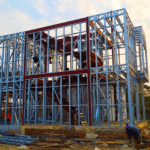What is the role of Prefabricated Buildings in Earthquake-Resistant Construction?
Introduction
Prefabricated buildings, also known as modular or pre-engineered structures, are becoming increasingly significant in the realm of earthquake-resistant construction. These structures are assembled from factory-produced components that are transported to the construction site and then assembled into a complete building. This approach offers several advantages, particularly in regions prone to seismic activity.
Advantages of Prefabricated Buildings for Earthquake Resistance
- Precision Engineering
Prefabricated buildings are designed and manufactured using advanced technologies and materials that ensure precise and consistent construction quality. The high degree of accuracy in prefabrication helps in achieving structural integrity and consistency, which is crucial for earthquake-resistant design. Components are often tested for their strength and durability, ensuring they can withstand seismic forces.
- Controlled Manufacturing Environment
Manufacturing prefabricated components in a controlled environment allows for better quality control compared to on-site construction. This controlled setting helps prevent common issues such as material defects, which can compromise the structural performance during an earthquake. Additionally, the factory setting minimizes the impact of weather and other environmental factors on construction quality.
- Rapid Construction
Prefabrication significantly speeds up the construction process. In earthquake-prone areas, this is particularly advantageous as it reduces the time during which construction workers are exposed to potential seismic risks. Faster construction also means quicker availability of buildings, which is crucial in disaster-stricken areas requiring immediate infrastructure.
- Modular Flexibility
Prefabricated buildings are inherently modular, meaning they can be designed to flexibly accommodate seismic requirements. Modular components can be engineered with specific seismic features, such as base isolators and shock absorbers, integrated into the design. This modularity allows for easy adaptation to various seismic codes and standards.
- Quality and Consistency
The use of prefabricated elements ensures uniformity across all components of a building. Consistent quality and design reduce the likelihood of weak points in the structure, which are critical in maintaining stability during an earthquake. Prefabrication also allows for the use of advanced materials and construction techniques that enhance the overall seismic performance of the building.
- Improved Safety for Construction Workers
With prefabricated buildings, much of the construction work is done off-site, reducing the time workers spend on scaffolding and in potentially hazardous conditions. This not only improves safety for construction workers but also contributes to a safer work environment overall.
- Design Innovations
The prefabrication process enables the incorporation of innovative design features that enhance earthquake resistance. For instance, components can be pre-engineered with built-in seismic isolation systems or energy-dissipating devices, which can significantly improve a building’s ability to absorb and dissipate seismic energy.
Conclusion
Prefabricated buildings play a crucial role in advancing earthquake-resistant construction by offering precision, quality, and efficiency. Their ability to be designed with specific seismic considerations, combined with the advantages of rapid assembly and improved worker safety, makes them an attractive option for earthquake-prone regions. However, successful implementation requires careful planning and consideration of logistical and integration challenges. As technology and materials continue to evolve, prefabricated buildings are likely to play an even more prominent role in creating safer, more resilient structures in seismically active areas.






















